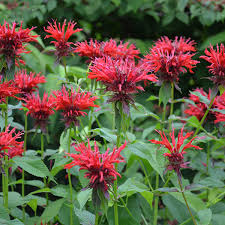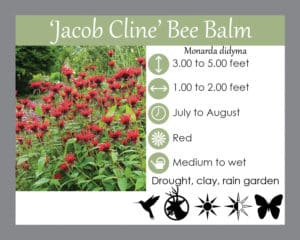Jacob Cline Bee Balm
Click Here to Get a Quote from our nursery!
LGS Notes: Supports a variety of wildlife and pollinators and is not enjoyed by deer. It’s a pretty tough plant so can be used in areas where it has space to roam free or other plantings haven’t been successful for you. I love the bright red color of this plant- it definitely adds pizazz to the summer garden. We use it in rain gardens since it’ll tolerate wet soil. It, as do the other bee balms, will likely get powdery mildew in wetter weather. I have not seen this infection necessarily come back in subsequent years or diminish the life force of the plant.
“A butterfly magnet, beebalm provides color and contrast for the perennial border, cottage garden, native plant garden, meadow, herb garden, naturalized planting or along ponds or streams. Hummingbirds also visit beebalm.Powdery mildew can be a serious problem, particularly in crowded gardens with poor air circulation. In addition, if the soil is allowed to dry out, the stressed plants become increasingly susceptible to disease. Rust can also be a problem.
Over 50 cultivars of scarlet beebalm are readily available from commercial sources. These cultivars have been developed for flower color, bloom period, plant height, disease resistance, flavor (teas), essential oil production, winter injury and deer resistance. Very large frilly red flowers. Possibly the best monarda to attract hummingbirds”


